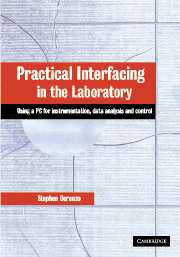Book contents
- Frontmatter
- Contents
- Preface
- Acknowledgments
- 1 Digital tools
- 2 Analog tools
- 3 Analog ↔ digital conversion and sampling
- 4 Sensors and actuators
- 5 Data analysis and control
- Appendix A Grounding and shielding
- Appendix B Experimental uncertainties
- Appendix C C programming tips
- Appendix D Numerical methods and C functions
- Appendix E Summary of Data Translation DT3010 PCI plug-in card
- Appendix F Using the digital oscilloscope to record waveforms
- Appendix G Electrical hazards and safety
- Appendix H Standard resistor and capacitor values
- Appendix I ASCII character set codes
- Glossary
- Index
- References
3 - Analog ↔ digital conversion and sampling
Published online by Cambridge University Press: 04 August 2010
- Frontmatter
- Contents
- Preface
- Acknowledgments
- 1 Digital tools
- 2 Analog tools
- 3 Analog ↔ digital conversion and sampling
- 4 Sensors and actuators
- 5 Data analysis and control
- Appendix A Grounding and shielding
- Appendix B Experimental uncertainties
- Appendix C C programming tips
- Appendix D Numerical methods and C functions
- Appendix E Summary of Data Translation DT3010 PCI plug-in card
- Appendix F Using the digital oscilloscope to record waveforms
- Appendix G Electrical hazards and safety
- Appendix H Standard resistor and capacitor values
- Appendix I ASCII character set codes
- Glossary
- Index
- References
Summary
Introduction
In this chapter, we discuss the components that convert data between the digital world of the microcomputer and its I/O ports and the analog world of continuously varying voltages. These are the digital-to-analog (D/A) converter, the analog-to-digital (A/D) converter, the sample-and-hold amplifier, and the comparator. We then go on to discuss some of the fundamental limits to sampling time-varying analog signals, including the role of the sample-and-hold amplifier, and the minimum sampling frequency.
Laboratory Exercise 7 is designed as an introduction to the characteristics of the D/A and A/D converters and uses an analog I/O circuit board. Laboratory Exercise 8 interfaces a D/A converter to the binary output port, measures its transfer characteristics, and uses it in waveform generation. Laboratory Exercise 9 interfaces an A/D converter to the binary input port and performs periodic sampling of sine waves. Laboratory Exercise 10 samples and recovers sine waves of various frequencies and explores the aliasing problems that arise when the input frequency is greater than one-half of the sampling frequency.
Digital-to-analog converter circuits
The digital-to-analog (D/A) converter changes an N-bit binary number to an analog output voltage that can have 2N distinct values. It consists of resistors, switches, and an amplifier. Frequently, input latches are provided to retain the input number. Usually, the relationship between the input number and the output voltage is linear, but other relationships (e.g. logarithmic) are also used.
- Type
- Chapter
- Information
- Practical Interfacing in the LaboratoryUsing a PC for Instrumentation, Data Analysis and Control, pp. 153 - 200Publisher: Cambridge University PressPrint publication year: 2003



